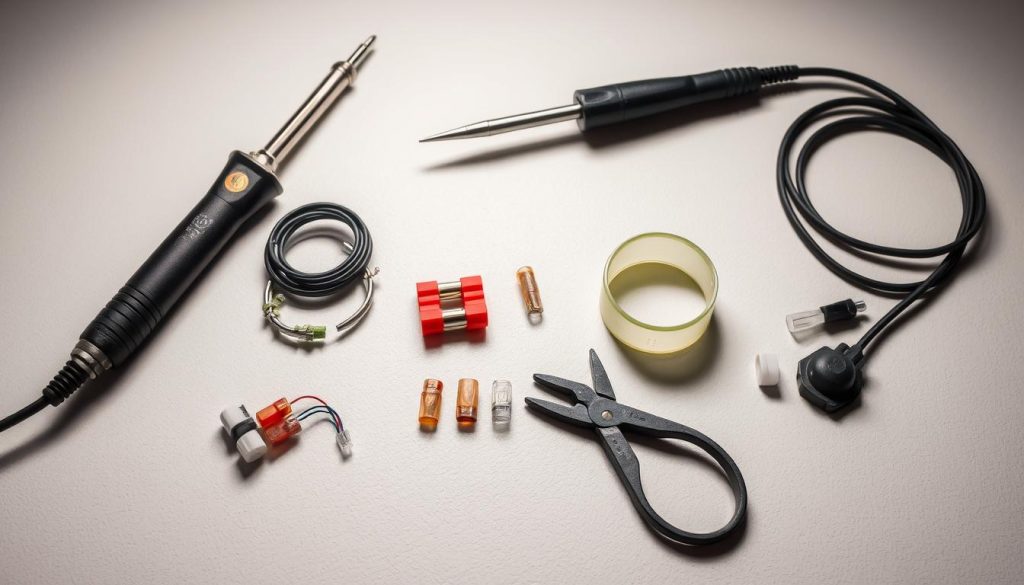
What to Do When Your Car Window Won’t Roll Up

What Causes Windshield Chips in Texas?
Driving in cold or humid weather can be tough, even more so when your rear defogger isn’t working. A good defogger is key to keeping your view clear while driving.
Your car’s defogger helps remove fog and ice from your rear window. This makes driving safer. If it breaks down, it can be very dangerous. Knowing why and how to fix rear defogger problems is vital for drivers.
Having trouble with fog removal? It’s probably because your defogger system isn’t working right. Don’t fret, we’ll look at why it happens and how to fix it so your defogger works again.
Key Takeaways
- Understanding the importance of a functioning rear defogger for safe driving.
- Identifying common causes of rear defogger failure.
- Learning practical fixes to restore your defogger’s functionality.
- Recognizing the role of maintenance in preventing defogger issues.
- Knowing when to seek professional help for defogger repairs.
Understanding Your Rear Window Defogger System
It’s important to know how your rear window defogger works. This system is a key safety feature. It clears fog, frost, or condensation from the rear window, giving you a clear view while driving.
How Rear Defoggers Function
Rear defoggers use electrical connections to heat up a grid of lines on the rear window. When you turn on the defogger, an electrical current warms the glass. This makes any moisture evaporate, clearing your view.
Components of a Defogger System
The defogger system has several important parts. These include the defogger switch, relay, fuse, wiring, and the heater grid on the rear window. Each part is vital for the system to work right. For example, the switch lets you turn the defogger on and off. The relay and fuse protect the circuit from too much power.
The Importance of Clear Visibility
Being able to see clearly is essential for safe driving. If your rear window defogger doesn’t work, it can make it hard to see what’s behind you. This increases the risk of accidents. So, it’s important to understand and keep your defogger system in good shape.
The table below shows the main parts of a rear window defogger system and what they do:
| Component | Function |
|---|---|
| Defogger Switch | Activates or deactivates the defogger system |
| Relay | Acts as an intermediary to supply power to the defogger grid |
| Fuse | Protects the electrical circuit from overload |
| Heater Grid | Heats up to clear fog, frost, or condensation from the rear window |
| Wiring | Connects the various components of the defogger system |
Common Rear Window Defogger Issues
Rear window defoggers often have problems, and knowing why helps fix them. If yours isn’t working right, it can make driving harder, mainly in wet or snowy weather.
Complete System Failure
When your defogger stops working, it’s a big problem. It might be a blown fuse, a bad switch, or wiring issues. Always check the fuse box first. A blown fuse is easy to fix.
Partial Heating or Uneven Defrosting
Uneven defrosting or partial heating points to a grid problem. Broken or damaged grid lines can cause issues. Check the grid for damage and fix or replace it if needed.
Delayed Activation
Defoggers sometimes start late, which is annoying. There are a few reasons for this:
Temperature-Related Delays
In very cold weather, defoggers might take longer to start or work less well. This is because they’re made for certain temperatures.
Electrical Connection Delays
Bad electrical connections can also cause delays. Corrosion or loose connections can slow down the electricity flow, making the defogger start late.
Key issues to watch out for:
- Blown fuses or circuit issues
- Damaged or broken grid lines
- Poor electrical connections
- Faulty switches or wiring problems
Understanding these common problems is the first step to fixing your rear window defogger. Whether it’s a simple fix or a bigger repair, knowing what’s wrong is key to driving safely again.
Electrical Problems Causing Defogger Failure
Electrical problems often lead to rear window defogger failures. It’s important to understand these issues to fix them. The defogger system needs electrical connections to work right.
Blown Fuses and Circuit Issues
A blown fuse is a common electrical problem with defoggers. It might happen because of a power surge or a short circuit. Check your vehicle’s fuse box and replace any blown fuses for the defogger.
Switch Malfunctions
The switch that controls the defogger can also go wrong. If it’s faulty, you might need to replace it to get it working again.
Wiring Damage
Wiring damage is another big problem. It can be caused by wear and tear, rodent damage, or corrosion.
Rodent Damage
Rodents love to chew on wiring, causing damage. Look for signs of rodent damage on the wiring to find the problem.
Corrosion Issues
Corrosion on electrical connections can stop the defogger from working. Clean these connections regularly to avoid corrosion.
To keep your defogger working well, fix electrical problems quickly. Regular checks can spot issues before they get worse.
Heater Lines and Grid Damage
When your rear window defogger isn’t working right, it might not be the electrical system’s fault. It could be the heater lines or grid damage. These lines are key for the defogger to work, as they warm the rear window to clear fog and ice.
Physical Damage to Conductive Lines
The conductive lines in the defogger grid can get damaged. This can happen from accidents, wrong cleaning, or even when they’re made. If these lines break, the defogger can’t warm the window well, making fog removal hard.
Wear and Tear Over Time
Heater lines can wear out over time. This is because of weather, temperature changes, and other environmental factors. As they wear, the defogger’s ability to clear fog and ice from your rear window gets worse.
Impact of Window Tinting on Defogger Performance
Window tinting helps block glare and heat, but it can also affect the defogger. Some tints can stop the electrical current needed for the heater lines. It’s important to pick a tint that works with your car’s defogger system to avoid problems.
Knowing why heater lines and grids can get damaged helps you keep your rear window defogger working well. This ensures you can see clearly while driving.
Diagnosing Your Rear Window Defogger Issues
To find out why your rear window defogger isn’t working, you need to check a few things. First, look for any damage or wear on the defogger grid. Then, test the electrical connections. You might also need a multimeter for more detailed checks.
Visual Inspection Techniques
Start by looking closely at the defogger grid. Check for any broken lines or corrosion. Also, see if the grid lines are damaged or worn out. If you find any damage, it might be the cause of the problem.
Testing Electrical Connections
Bad electrical connections can stop your defogger from working. Look at the wiring and connectors for damage or corrosion. Make sure all connections are tight and clean. Cleaning corroded connections might fix the issue.
Using Multimeters for Troubleshooting
A multimeter is great for finding electrical problems. It helps with voltage and continuity tests.
Voltage Testing
For voltage testing, set your multimeter to the voltage setting. Check the voltage at the defogger grid terminals. If there’s no voltage or it’s too low, it could mean a wiring or switch problem.
Continuity Testing
Continuity testing shows if there’s a break in the circuit. Use the multimeter’s continuity setting to test the defogger grid. If it beeps, there’s continuity. If not, there’s a break.
By following these steps, you can find and possibly fix your rear window defogger issues. This will help you see clearly during bad weather.
DIY Fixes for Common Defogger Problems
Simple DIY fixes can solve common defogger problems. This keeps your rear window clear for safe driving. A malfunctioning defogger needs quick attention.
First, find out why it’s not working. It might be a blown fuse, damaged grid lines, or dirty connections.
Replacing Fuses
A blown fuse can stop your defogger. Replacing it is easy. Look for your vehicle’s fuse box and find the defogger fuse. Your manual or the fuse box cover can help.
Once you find it, pull out the fuse and check it. If it’s blown, swap it with a new one of the same rating.
Repairing Broken Grid Lines
Broken grid lines can mess up your defogger. You’ll need a repair kit for this. Clean the area with rubbing alcohol and a soft cloth first.
Then, follow the kit’s instructions to apply the repair paste. Make sure to trace the damaged line carefully. Let it dry before testing the defogger. For more help, check this guide on fixing broken rear windshield defroster.

Cleaning Electrical Connections
Dirty or corroded connections can stop your defogger. Cleaning them regularly keeps them working well.
Connector Maintenance
Start by disconnecting the battery to avoid shorts. Use a wire brush or a cotton swab with electrical cleaner to clean the connectors. Reconnect the battery and test the defogger.
Ground Point Cleaning
The ground point also needs regular cleaning. Find the ground point, usually a metal bolt or screw, and clean it with a wire brush. This ensures a good connection.
| DIY Fix | Description | Tools Needed |
|---|---|---|
| Replacing Fuses | Replace a blown fuse with a new one of the same amperage rating. | Fuse puller, new fuse |
| Repairing Grid Lines | Use a defogger repair kit to fix damaged grid lines. | Defogger repair kit, rubbing alcohol |
| Cleaning Connections | Clean dirty or corroded electrical connections and ground points. | Wire brush, electrical contact cleaner |
With these DIY fixes, you can fix common defogger problems. This keeps your rear window clear in bad weather.
Recent Developments in Fog Removal Technology
Fog removal on rear windows has seen big improvements in recent years. These changes have made rear window defoggers work better. Now, drivers can see more clearly, making the roads safer.
Advanced Defogger Systems in New Vehicles
New cars come with advanced defogger systems. These use new materials and tech. They often have automatic temperature control and smart sensors for better defogging.
These updates help rear windows clear faster. They stay clear in different weather too.
Aftermarket Solutions for Older Cars
Older car owners can get upgrades for their rear window defoggers. Options include retrofitting new grid lines or installing new controllers. These upgrades make defogging much better, like in newer cars.
Smart Defogger Technology Trends
Smart defogger technology is becoming more popular. These systems can automatically detect fog and adjust. They work with the car’s computer for real-time monitoring and adjustments.
As tech keeps improving, we’ll see even better fog removal solutions soon.
When to Seek Professional Help
Knowing when to get help for your rear window defogger can save you time and avoid more damage. While you can fix some problems yourself, others need a pro’s touch.
Complex Electrical Issues
For complex electrical problems like faulty wiring or switches, get a pro. These issues are hard to fix without the right tools and knowledge.
Complete Grid Replacement Needs
If the defogger grid is badly damaged, you might need a full replacement. This job needs special skills and knowledge, best left to experts.
Warranty Considerations
Before you try to fix it yourself, check your warranty. DIY repairs can sometimes void your warranty, so it’s important to know your terms.
| Issue | DIY Fix | Professional Help |
|---|---|---|
| Complex Electrical Issues | No | Yes |
| Complete Grid Replacement | No | Yes |
| Warranty Considerations | Check Warranty | Recommended |
By knowing when to get professional help, you can fix your rear window defogger right. This keeps your view clear and safe while driving.
Preventing Future Rear Window Defogger Issues
To keep your rear window defogger working well, regular maintenance is essential. A well-maintained defogger ensures clear visibility during your drives, even in cold or humid conditions.
Proper Maintenance Practices
Start by regularly checking your rear window defogger grid for damage or wear. Clean the grid gently with the right materials to prevent problems. Also, inspect the electrical connections for corrosion or damage.
Avoiding Damage to the Grid
Be careful when cleaning your rear window to avoid damaging the defogger grid. Use soft cloths and avoid harsh chemicals. Also, watch out for objects that could scratch or damage the grid.
Regular System Testing
Test your defogger regularly, before winter or in humid seasons. Seasonal testing recommendations include turning on your defogger and checking for even heating across the grid.
Seasonal Testing Recommendations
Before winter, make sure your defogger works well for foggy conditions. In humid climates, check the defogger more often.
Warning Signs to Watch For
Look out for signs like uneven heating, slow activation, or complete failure to heat. These signs mean your defogger needs attention. Addressing these issues promptly can prevent further damage.

Conclusion: Ensuring Clear Visibility for Safe Driving
A working rear window defogger is key for safe driving, more so in rainy or cold weather. Problems with it can make driving hard due to foggy or icy windows. Knowing why these issues happen helps you fix them.
Regular checks and maintenance can stop fog issues. Look at your electrical and heater lines often. This keeps your defogger working right. If problems keep coming back, get expert help.
At Miracle Auto Glass, experts can fix any windshield or glass damage. Keeping your vehicle’s glass in top shape is essential for safety. Visit Miracle Auto Glass for quick and reliable service.




